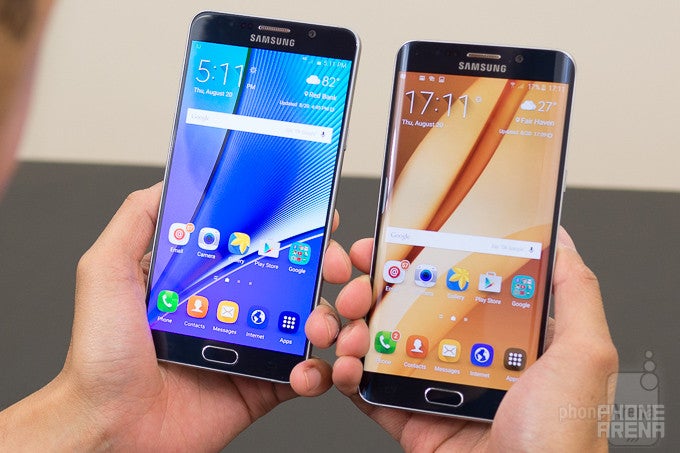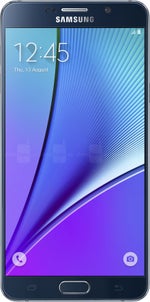Samsung Galaxy Note5 vs Samsung Galaxy S6 edge+

Introduction
It’s not even September yet, but things are surely heating up as we eventually get into the thick of things with the upcoming holiday season. After having such a rousing hit with its two premium offerings from earlier the year, Samsung isn’t wasting any time by launching two other high-prized prized devices in its stable – the Samsung Galaxy Note5 and the Galaxy S6 edge+. These two new entrants undoubtedly help to diversify the company’s portfolio, which is still generating interest from consumers all around after the release of the Galaxy S6 and S6 edge.
Following the same path they’ve threaded last year, where they also unveiled two phablets for the fall season, we’re faced with nearly the same predicament as before – wherein there’s a decision needed for which of the two should you buy. Like last year, the differences between the two are mostly subtle, but meaningful. We know, it’s tough cookies considering the hefty amount you’ll need to shell to pick up either of them, but we’ll do our best to dissect exactly what accompanies each one.
Design
First, let’s talk about the good between their designs. That, folks, has to be none other than their premium exteriors – ripped from the Galaxy S6 and S6 edge that preceded them. While we’re not as enthused this time around, we still have to point out the exceptional quality that’s oozing from the seams with their metal-meets-glass construction. They’re beautiful no matter what angles they’re viewed from, just because there’s a dazzling show produced when light bounces off their glass surfaces.
The more we look at the two, we’re still compelled by the slicker aesthetics that accompany the Galaxy S6 edge+. Naturally, it’s due to the dual-curved display, which also made the Galaxy S6 edge stand out over the standard Galaxy S6.
The Galaxy Note5 is the more ergonomic to hold in the hand of the two, and in the long run, much more comfortable to hold, despite it being the being ever so slightly wider, thicker, and heavier. Sure, they’re both slick feeling and prone to smudges due to the glass surfaces, but our hand is better able to grasp the Galaxy Note5 because of how those curved edges in the back conform to our grip. Conversely, the Galaxy S6 edge+ still exhibits a subtle of sharpness around its sides and it just never feels as natural to hold. All told, the Galaxy S6 edge+ earns the style award – whereas the Galaxy Note5 feels better in the hand thanks to its proper ergonomics.
Despite that, the two share the same set of arsenal that make them so cutting edge. Specifically, they feature the same lickety-split finger print sensor, heart rate sensor in the rear to measure our pulse, built-in wireless charging, and rapid charging microUSB 2.0 ports. Even the placement of their buttons and ports is the same, so there’s no one that has an advantage over the other. By now, though, we all know what makes each one so unique. For the Galaxy Note5, it comes with that pressure sensitive stylus we’ve come to know and love with the series – while the Galaxy S6 edge+, as its name implies, gets its uniqueness from its dual-curved display.
Display
On the specs side, the two behemoths share nearly identical 5.7-inch 1440 x 2560 (Quad-HD) Super AMOLED displays. But of course, the visual difference here is in how the Galaxy S6 edge+’s screen is curved on both edges. At the very least, details are exquisitely sharp and plentiful, so there’s equal balance in this regard. Beyond that, there are some qualities that favor one over the other in certain categories, but for the sake of argument, we’re dealing with similarly performing screens.
Well, it’s made more evident by quickly glancing at how they perform in our benchmark tests. First and foremost, visibility under direct sunlight isn’t a problem, as they both generate enough potent luminance – 470 nits for the Galaxy Note5, and 496 nits with the Galaxy S6 edge+. In the color temperature department, there’s little deviation seen in their ~6700K productions. And as we’ve seen, too, Samsung is excelling in the art of delivering well-calibrated screens, which is evident in how they similarly achieve almost the same target values in the sRGB color spectrum chart.
Interface and Functionality
At the core of it all, they’re running the latest version of Sammy’s TouchWiz UI experience on top of Android 5.1.1 Lollipop. From a superficial standpoint, every aspect of the experience is identical on both devices, so you can expect the same trimmed down, less offensive TouchWiz we’ve been seeing of late. While they’ve eliminated several redundant features, it’s still an incredibly versatile custom experience that caters to a wide range of folks. From the ease of operation that accompanies its easy mode, to the multi-tasking usefulness of Multi-Window, TouchWiz still remains a rich and encompassing experience.
When it comes to the visuals, they’re identical as well with the subtle changes Samsung has made to the icons in the home screen. Beyond that, there’s still diversity in the form of TouchWiz’s ability to download custom themes, and a one-handed mode that minimizes certain screens to a thumb friendly reaching size. Going back to what we said earlier, each phone employs its own unique features, so depending on your needs, either one will suffice more than the other. Let’s take a look!
Out of the two, we’ll give the Note5 the overall advantage, primarily because we feel that its S Pen related features are far quite valuable and impactful to the overall experience. Not only does the S Pen complement the way we interact with the phone, but it does a decent job to replicate the paper and pen experience. With the new arsenal of features that accompanies this S Pen, it’s pretty awesome that we can quickly jot down something using its new screen off memo feature.
In contrast, we feel that the Galaxy S6 edge+’s features pertaining to its dual-curved display aren’t as meaningful. For example, do we really want to place the phone face down on its display for its edge lighting feature to work? Not really, especially when there’s a chance of scratching the screen. At the same time, too, the new apps edge pane is a nice addition to the experience, but it’s just another form of multi-tasking.
All told, the Galaxy Note5 continues to be a productive beast that’s unchallenged in the space. Aided already by a strong experience courtesy of TouchWiz, the various S Pen functions help to broaden its overall worth over the Galaxy S6 edge+.
Processor and Memory
Samsung made some bold claims when they said that the Galaxy S6 and S6 edge were its fastest phones to date. Knowing the kind of raw power produced by them, Samsung didn’t steer away from gracing its two newest phablets with the same hardware – a 14nm Exynos 7420 SoC, broken down to four Cortex-A57 cores clocked at 2.1GHz, and another four Cortex-A53 running at 1.5GHz. Unlike the Galaxy S6 and S6 edge, Samsung has upped the RAM to a generous 4GB on both the Note5 and Galaxy S6 edge+.
In true fashion, the two are exceptionally responsive with all sorts of operations. From the simple and effortless ones, to the intensive and demanding stuff, it’s undeniable that they’re powerful to handle everything that’s thrown at them. To tell you the truth, we don’t find any particular one to be better than the other, which is soundly confirmed by looking at their benchmark performances. The only area of concern relates to graphics processing, as the Quad-HD resolutions of the two screens can sometimes be taxing to the GPU.
Offered in both 32GB and 64GB capacities, they utilize UFS 2.0 type memory for super-fast read/write speeds. For some, that’s a comforting reality, but the lack of microSD card slots will still irk others.
Internet and Connectivity
From a superficial level, they deliver exceptional web browsing experiences that we find satisfying. From their speedy data rates, the generous real estate of their screens, and snappy navigational controls, there’s nothing to complain about here whatsoever. Yet, it’s the Note5 that earns some additional adulation because the S Pen is an effective tool that enhances the experience – not only for how it acts as a cursor to interact with certain elements, but for being a precise selection tool as well. You don’t get that with the Galaxy S6 edge+.
On the connectivity side of things, they’re equipped with pretty much the same arsenal, so that includes things like aGPS with Glonass, Bluetooth 4.2, dual-band 802.11 a/b/g/n Wi-Fi, and NFC. What’s slightly different, though, is how the Note5 benefits from having LTE-A category 9 support for theoretical speeds of up to 450/100 Mbit/s. Meanwhile, the Galaxy S6 edge+ offers LTE-A category 6 support, which reaches theoretical speeds of 300/50 Mbit/s.
Camera
After some investigating, it was revealed that both the rear 16-megapixel cameras of the Galaxy Note5 and Galaxy S6 edge+ are Sony-made IMX240 sensors – a 1/2.6" unit with 1.12μm pixels. They’re accompanied by OIS, f/1.9 aperture lenses, and single LED flashes, which make them so versatile for a number of shooting occasions. As for their wide-angle 5-megapixel front-cameras, they’re Samsung-made ISOCELL sensors, which were used already for the Galaxy S6.
Running the camera app, there’s no surprises finding the same set of tools, shooting modes, and manual controls on both smartphones. Novice users will enjoy the simplicity that comes with the automatic mode, but Samsung has added shutter speed adjustment to the ‘Pro’ mode to give enthusiasts even more control in shooting photos under low light. Given that the Galaxy S6 edge+ has those slick looking curved edges, you’d think that Sammy would’ve attempted to add some new functions with the camera experience, but that’s hardly the case.
Image Quality
We know what you’re thinking, the quality from the two cameras should be 100% identical, right? Well, if you’re looking at the overall result, we can agree to an extent that the two deliver the same outstanding results. As we comb through the photos, however, we do find just one miniscule difference that gives the Note5 just a smidgen more edge.
First and foremost, they both take exceptional outdoor photos that are filled with sharp details and rich colors to warrant physical printouts. Even better, the immense amount of detail captured by their cameras allow us to crop images later on without much impact to the quality. If we’re to meticulously look closer between the two, we do notice that the Note5 captures just a fraction more detail than the Galaxy S6 edge+. Honestly, it’s tough to see in most cases, but trust us, it’s there.
Beyond that one single item, they both perform similarly to one another in other scenarios. Under low light, it looks as though the ISO is bumped up to brighten up the scene, but in the process, details tend to come out grainy looking – losing the sharpness we get from broad daylight shots. In combating that, we can switch to their ‘Pro’ modes and set the shutter speed to a longer time. Even though this process helps to minimize the loss in detail, it means that you’ll need to keep the phone extremely still to prevent blurring from happening.
Overall, there’s no arguing the prowess of both cameras, but if you’re really particular about the details, the Note5 will ensure you obtain the utmost best results. Aside from that, we’re pretty content with the impeccable looking shots produced by the two.
Video Quality
Variety is such a good thing to offer! Thankfully so, the Galaxy S6 edge+ and Note5 provide us with a wealth of resolutions to capture video. Specifically, we have 3840 x 2160 UHD, 2560 x 1440 QHD, 1080p 60fps, 1080p 30fps, 720p, and VGA. Not to mention, we also have fast and slow motion capture in our tool box as well.
Even though we’re able to spot a small detail between the Note5 and Galaxy S6 edge+’s still shot performance, it’s basically non-existent here, as the two phablets are totally capable of shooting slick video footage. Best of all, they’re accompanied with several high quality characteristic that make them especially versatile to use – like their clear audio recording, stabilization, gradual exposure adjustment, and reactive continuous auto-focus. Needless to say, there are so many reasons to go with UHD recording over the other modes, but 1080p recording is more can usable with the two.
Multimedia
Paying attention to their music players, we can choose between Google Play Music or Samsung’s own bundled TouchWiz music player. Whichever you end up going with, just know that they’re both identical – so there’s no advantage with one over the other.
Playing music and listening to the quality produced by their respective speakers, the Galaxy S6 edge+ generates a stronger 73.1 dB output – whereas the Note5 comes up short at 70.7 dB. In all fairness, it’s almost tough to discern the difference in wide open rooms where audio is bouncing off everywhere. Either way, we can attest that they’re effective to cover small spaces with enough authority, but there’s some sharpness evident at their loudest volumes.
Additionally, it’s the Galaxy S6 edge+ that produces the stronger output through the 3.5mm headphone jack, but it’s hardly noticeable in real life. With these two new phablets, Samsung has added support for ultra-high quality audio (UHQA) to upscale and enhance the quality for a clearer listening experience. In our testing, though, the only thing that’s realized with it turned on is a slight boost in bass and treble – nothing more than that.
When it comes to playing videos, both are more than capable of delivering a tantalizing experience. It’s made more poignant by setting their displays to ‘adaptive’ mode, which adjusts the contrast and color saturation appropriately for the most optimal viewing experience. And boy do videos comes to live on their breathtaking Super AMOLED displays! Obviously, there’s a multi-tasking element in play with the two by leveraging the pop-up feature.
Call Quality
While they’re not totally perfect, we’re pleased with the overall quality they’re able to produce. What’s especially nice is the addition of an extra volume mode while in a call, which as its name implies, ups the volume through the earpieces to make them more than sufficient to use when it’s noisy. However, the Note5 tends to exhibit some crackly tones with voices through the earpiece, which is something that’s not evident with the Galaxy S6 edge+. To that degree, we give the Galaxy S6 edge+ has the slight upper edge.
Battery
Comparing their thickness, one would imagine that we’d find a higher capacity battery in the Note5, but that’s not at all the reality of things, as the two phablets are endowed with the same 3000 mAh cell. When it comes to our everyday usage, we find the two more than comparable with one another by delivering a solid one-day of juice – where they’re both generally at the 25% level before calling it quits.
In our battery benchmark test, however, it reveals that the Galaxy S6 edge+ is just a bit longer with its battery life. Specifically, it achieves a time of 9 hours and 29 minutes, making it one of the best performing phones in the space at the moment, but the Note5 isn’t too far behind at a respectable 9 hours and 11 minutes. Samsung also made some bold claims regarding the speediness of the two phones when it comes to their recharge time. True to their word, the Note5 and Galaxy S6 edge+ are some of the fastest charging phones out there – taking a mere 81 and 80 minutes respectively. Now that’s incredibly fast!
Conclusion
Rather than going into detail about their pricing, we’ll just generalize it by saying that the Galaxy S6 edge+ carries a higher premium than the Note5. There might not be a huge disparity when breaking down their pricing on a fixed, monthly financing plan, but it’s undeniably profound when we look at their outright costs. In fact, the Galaxy S6 edge+, depending on which carrier you buy it from, is normally accompanied with an $80 increase over the Note5. Again, it’ll be different for each carrier, but that’s the cost we’re roughly looking at here.
Absorbing all of that, it boils down now to which of the two phones should you pick up. If we’re to factor in their performances and the kind of value brought on by their pricing, we’d give the nods to the Note5 purely because of the added benefit that comes with its S Pen. Not only from a utility point of view, but also in terms of the value brought on by the features that accompany it. For the most part, we find them more meaningful and impactful than the features of the dual-curved display with the Galaxy S6 edge+. We will, however, say that the Galaxy S6 edge+ boasts the slicker design.
Ultimately, though, it comes down to personal preference. Indeed, the Note5 comes at us with a more rounded package, but the Galaxy S6 edge+ still carries its own noteworthy qualities to attract consumers. However, the difference in cost might open peoples’ eyes to take notice of the Note5’s extended worth.

Follow us on Google News



















![A new Android bug is making it impossible to install new apps. Are you affected? [UPDATE]](https://m-cdn.phonearena.com/images/article/176703-wide-two_350/A-new-Android-bug-is-making-it-impossible-to-install-new-apps.-Are-you-affected-UPDATE.webp)

Things that are NOT allowed:
To help keep our community safe and free from spam, we apply temporary limits to newly created accounts: